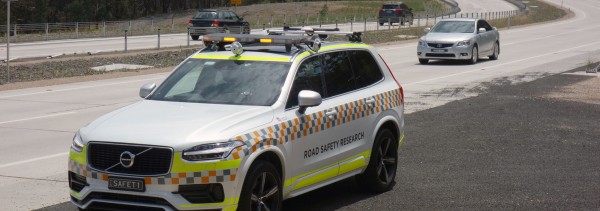
CAV Network Readiness case study
Image

Image controls:
Automated Vehicle Infrastructure Initiative
In March 2018, we set out to assess the compatibility of Sydney’s motorway infrastructure with automated vehicle technology. In a joint project between Transurban and eight vehicle manufacturers - including BMW, Tesla, Hyundai, Volvo, Mercedes-Benz, Audi, Range Rover and Lexus – Transport for NSW and Roads and Maritime Services have investigated the compatibility of lane markings, speed signs, variable message and other road conditions on the systems supporting automated driving.
In a joint project between Transurban and eight vehicle manufacturers - including BMW, Tesla, Hyundai, Volvo, Mercedes-Benz, Audi, Range Rover and Lexus – Transport for NSW and Roads and Maritime Services have investigated the compatibility of lane markings, speed signs, variable message and other road conditions on the systems supporting automated driving.
This project was carried out on the Sydney Orbital Network including the Lane Cove Tunnel, the Hills M2 Motorway, Westlink M7, the M5, Eastern Distributor, and the Sydney Harbour Bridge and Harbour Tunnel. The plan is to extend the project to the broader state and regional highway networks over the next three years.
Data from the trial is being logged and analysed for planning the safe introduction of the automated vehicles and sets the platform for future road audits by Transport for NSW’s Centre for Road Safety.
Cooperative Intelligent Transport Initiative
This initiative was established in 2013 to test the capability of in-vehicle devices to communicate with road infrastructure such as traffic lights through the Sydney Coordinated Adaptive Traffic System (SCATS®) as well as connected vehicles.
The ultimate goal of the Cooperative Intelligence Transport Initiative (CITI) testbed is to establish the benefits and risks associated with connected vehicles. The project includes a wide range of vehicles including up to 60 trucks, 11 buses, 49 light vehicles and motorcycles.
Phase 1 of testing established 22,000 kilometres of test-ready road, from the Northern Beaches of Sydney to Kiama on the south coast of NSW and is testing is planned to expand into the Sydney Metropolitan area. These tests have provided an understanding around the accuracy of satellite positioning data and the use of radio frequency technology to “see” past line of site obstructions such as buildings.
The CITI project has also been generating interest worldwide, having been showcased in the United States, United Arab Emirates, Qatar and Singapore. This has helped to establish NSW as a world leader in the research of Cooperative Intelligent Transport Systems (C-ITS) technologies, especially in their application in the freight sector.
Image

Image controls:
